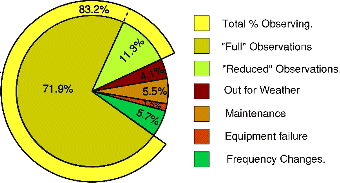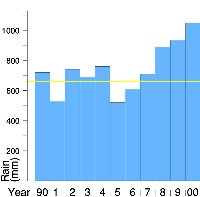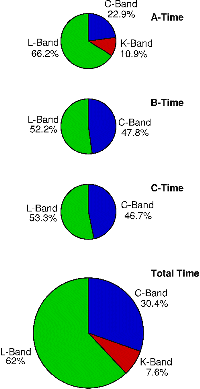MERLIN OPERATIONS
The MERLIN target for operation is normally 24 hours per day for 9 months of the year except for a weekly maintenance period not exceeding 8 hours and the time required for PATT-requested frequency changes. During the remaining 3 months of the year, usually in the summer/early autumn, major mechanical maintenance work, painting of telescopes and development takes place. A frequency change also usually takes place during this 3 month period. During the two years covered by this report, the MERLIN Steering Committee authorised extensions of the summer maintenance period to four months, to facilitate major engineering works as part of the restructuring programme. Efficient scheduling of the engineering work held the actual down time to 3.8 months, 0.75 months of which was used for EVN observations by the Mk2 and Lovell telescopes. The frequency flexibility implemented as part of this engineering programme is already paying dividends when considering the number of K-Band astronomical programmes that are being completed. The new ability to switch almost instantaneously between C-Band and K-Band has resulted in more K-Band proposals being completed during the past 2 years than ever before. When one considers the appalling weather during these 2 years, this represents a major improvement in the operational efficiency of MERLIN. In the past it could have taken a few weeks to make this frequency change with no guarantee of good weather. With further investment, the benefits of frequency flexibility can be extended to include L-Band. This is already available on the Cambridge and Mk2 telescopes and will be implemented at Defford from Autumn 2001.

Left: Summary of the operational status of MERLIN during 1999 and 2000.
During Semesters 99A, 99B, 00A and 00B, MERLIN has operated in its
three main frequency bands; L-Band, C-Band and K-Band. The actual time
spent in observations within each band has been set by astronomical
demand as determined by the MERLIN Time Allocation Group, the EVN
Programme Committee for the MERLIN+VLBI observations and, in the case of
K-Band observations, the state of the weather. As indicated earlier, the value
of the "frequency flexibility" programme was demonstrated in the
number of K-Band proposals completed, more than ever before. The
apparent imbalance in the time allocated to the different observing bands has
been due to three L-Band programmes classified as "key-programmes"
which required very deep integrations and hence a lot of time, and also to
a greater demand for L-Band observations. However, it is already
known that for the year 2001, C-Band proposals will dominate.
Of the programmes allocated time by PATT during 1999-2000, 92% of
the A-priority and 86% of the B-priority were completed (Appendix B).
Less than 100% completion of the L-Band programmes allocated time
was primarily due to interference preventing observations at some
frequencies corresponding to redshifted hydrogen. Interference at L-Band
frequencies is increasing all the time, though it has recently been possible to
have some of the interfering signals switched off for periods of time.
Weather prevented the K-Band A-priority programmes from being completed.
The adjacent pie charts show the distribution of actual observed time
by observing band.
The flexible scheduling policy for MERLIN means that a number of
time-constrained observations, such as those of a new nova, can be made
at short notice. The MERLIN Director also has at his disposal 2 days
per Semester for observations of an immediate urgency.
Such Target-of-Opportunity observations are provisionally allocated by
PATT and, when made, are classified as A-priority observations and have
been included as A-priority in the pie-charts.
A summary of the operational status of MERLIN is given in the pie
chart for the period of time which was available for observations during
the Calendar years 1999 and 2000. Included in the time for maintenance
is almost a day at the millennium, during which time MERLIN was
not operated for safety reasons in case of possible computer or utility
failure. As a result of a systematic and comprehensive programme to
identify and correct potential Y2K faults, none occurred within the MERLIN
system. The sector labelled "reduced" observations indicates the sum total of short
periods when some fault or bad weather affected or prevented the
operation of a single telescope, the loss of which was not considered
to have a significant effect on the final images produced other than
a degradation in the signal-to-noise. This figure is significantly higher
than in previous periods primarily due to "teething" problems with the
new drive system of the Darnhall telescope - the first to be replaced.
Low-level faults continued to occur over many months before their cause was
finally eradicated by the National Facility engineers in conjunction with
the company supplying the drive system. It can be seen that, including
this time, observations were made for 83.2% of the time. The 4.1%
down time caused by weather is, as for the period of the previous biennial
report, once again unusually high in comparison with that prior to the past
four years. The highest ever recorded rainfall in 1998 was superseded in
1999, which in turn was further superseded in 2000, during which year it
was over 400 mm above the yearly average at the Jodrell Bank site.
Although rain does not prevent the actual operations of the telescopes, it
does result in a degradation of observations at the higher frequencies.

Above: Rainfall figures for the Jodrell Bank site from 1990 to 2000.
